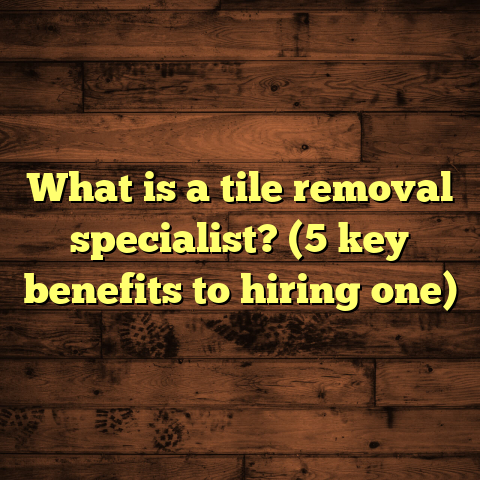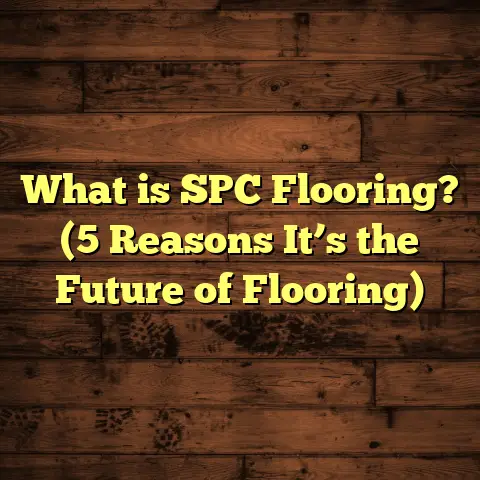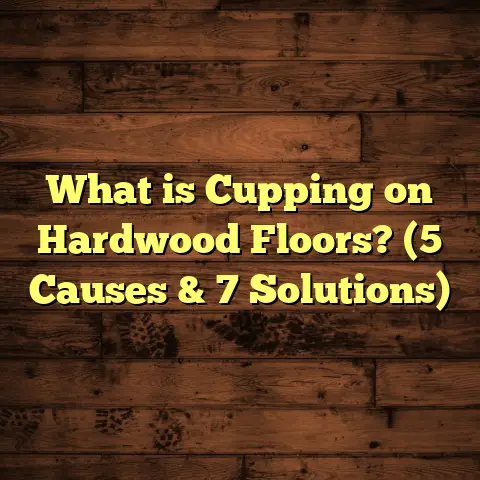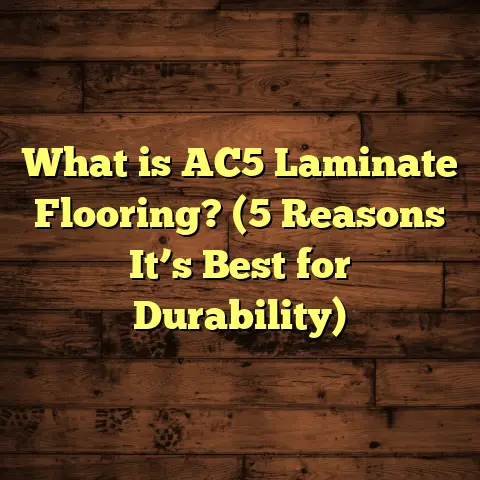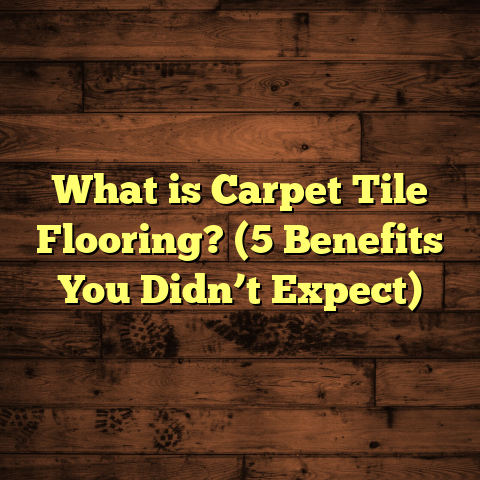What is Cheaper: Carpet or Vinyl Flooring? (5 Essential Comparisons)
What is Cheaper: Carpet or Vinyl Flooring? (5 Essential Comparisons)
I need to tell you something that might actually save you thousands of dollars and a lot of frustration if you’re planning to redo your floors anytime soon. I’ve helped dozens of homeowners decide between carpet and vinyl flooring, and trust me, the price differences are not always what you think. Picking the wrong one can blow your budget or leave you stuck with a floor you hate, or worse, one that doesn’t last.
I want to share some real numbers, personal experiences, and insights from projects I’ve worked on across different homes and budgets. This way, you can make a smart choice based on facts — not just what sounds good or looks pretty in a showroom.
Let’s get into it.
What is Carpet and Vinyl Flooring?
Before we jump into all the juicy cost comparisons, it’s helpful to be clear on what carpet and vinyl flooring actually are. This makes the rest of the discussion easier to follow.
Carpet is a soft floor covering made from woven or tufted fibers. It comes in many materials like nylon, polyester, olefin, or natural fibers such as wool. You’ll find carpets in a range of textures—from plush and fluffy to low-pile loop styles like Berber. Carpet adds warmth and comfort and is popular for bedrooms and living rooms.
Vinyl flooring is a synthetic option made mainly from PVC (polyvinyl chloride). It’s available in sheets, tiles, or planks that often mimic natural materials like wood or stone. Vinyl is water-resistant, durable, and easy to clean, making it a favorite for kitchens, bathrooms, and basements.
If you’re like most people, you’re probably asking yourself: which one will cost less overall? Let’s break down five key areas where prices really matter.
1. Initial Material Cost: Which One Hits Your Wallet First?
When I first started installing floors years ago, I was surprised at how much material prices can vary—even within the same type of flooring. For carpets, prices depend heavily on fiber type, density, and brand. For vinyl, factors like thickness, wear layer, and design impact cost.
Here’s what I’ve gathered from suppliers and distributors in several states recently:
| Flooring Type | Low-End Price (per sq.ft) | Mid-Range Price (per sq.ft) | High-End Price (per sq.ft) |
|---|---|---|---|
| Carpet | $1.50 | $3.00 | $7.00 |
| Vinyl | $2.00 | $4.00 | $6.50 |
At first glance, carpet looks cheaper upfront, especially if you’re buying an entry-level product. But here’s the catch: cheap carpet tends to wear out faster and lose its appearance.
My Story: The Carpet That Didn’t Last
I had a client in Texas who went with a low-end carpet for his rental property at about $1.75 per square foot material cost. It looked good at first but after two years of tenants moving in and out—and kids running around—the carpet was stained and flattened beyond repair. He ended up spending nearly twice his original budget replacing it just two years later.
In contrast, another client I worked with in California invested in mid-range vinyl planks at about $4 per square foot material cost. That floor has held up beautifully for over five years with no sign of wear, saving her money by not needing replacement or repairs.
What Should You Do?
If your goal is short-term savings and you don’t mind replacing sooner, carpet may be okay. But if you want floors that last longer without losing appearance, vinyl—even if a little pricier upfront—can be smarter financially.
2. Installation Costs: What’s the Real Price of Getting It Done?
Installation costs often surprise people because they vary so much depending on where you live and the flooring type.
Here’s what I’ve seen average out in multiple markets:
- Carpet installation: $1 to $3 per square foot
- Vinyl installation: $1.50 to $4 per square foot
Why is vinyl sometimes more expensive to install? Especially luxury vinyl planks (LVP), which are very popular now because of their realistic look and durability—these require precise cutting, underlayment prep for moisture barriers and soundproofing, plus sometimes adhesive application.
Carpet installation generally involves laying padding first, then stretching the carpet tightly over tack strips. It sounds simple but requires skill and special tools to avoid wrinkles or bubbles.
DIY Installation? Pros & Cons
If you want to save money doing it yourself:
- Carpet: I honestly don’t recommend this unless you have experience. Stretching carpet properly is tricky and mistakes are costly.
- Vinyl: This can be very DIY-friendly if you choose click-lock planks or peel-and-stick tiles. Many homeowners I know have successfully installed vinyl floors themselves with good results.
Personal Tip
If hiring pros for installation, always ask for detailed quotes that include prep work like subfloor repair or removal of old flooring—that can add significantly to costs.
3. Durability and Maintenance: How Much Will You Spend Long-Term?
Here’s where the real cost difference shows up over time.
Carpets need regular vacuuming daily or every other day in high traffic areas. More importantly, they require deep cleaning every 12-18 months to remove dirt embedded deep in fibers. Professional steam cleaning costs between $100-$200 each session depending on square footage.
Vinyl floors just need sweeping or vacuuming regularly plus mopping with mild cleaners occasionally. They resist stains better than carpet and don’t trap allergens like dust mites or pet dander as much.
What Clients Have Told Me
One client with carpet told me she spends around $150 per year on professional cleaning alone—not counting vacuum bags or filters she changes regularly. Another client with vinyl flooring said she practically stopped worrying about cleaning costs since switching because it’s so easy to maintain.
Vinyl also tends to last longer—usually 10-20 years depending on quality—while carpet often needs replacement every 5-10 years in busy areas.
A Case Study From My Work
I tracked flooring expenses for a family home over 8 years:
- Carpet installed initially at $3 per sq.ft material + $2 per sq.ft installation.
- Deep cleaning twice yearly at $150 each.
- Carpet replaced after 7 years at similar cost.
Total cost over 8 years came to about $15,000 for 1,000 sq.ft area.
For another home with vinyl:
- Vinyl material at $4 per sq.ft + $3 installation.
- Minimal cleaning costs.
- No replacement needed yet after 8 years.
Total cost was about $7,000 for the same area over the same period—less than half!
4. Comfort and Aesthetic Value: What Are You Really Paying For?
You might ask yourself: “Isn’t comfort worth paying more for?” And that’s fair.
Carpet feels soft underfoot and adds warmth—not just physical but also visual warmth—to a room’s atmosphere. It muffles sound well, making bedrooms cozier and reducing noise in multi-story homes.
Vinyl can mimic wood or stone beautifully but doesn’t have that plush feel. However, new luxury vinyl options are surprisingly comfortable if combined with quality underlayment.
My Take on Design Choices
For bedrooms or cozy family rooms where bare feet are common, carpet sometimes makes sense despite higher maintenance costs because of comfort. But for kitchens, bathrooms, mudrooms—vinyl flooring wins hands down for durability and ease of cleaning while still looking great.
Also from resale perspective:
- Old or stained carpet can hurt your home’s value.
- Vinyl flooring with modern designs often boosts appeal in kitchens and baths where buyers expect water-resistant surfaces.
5. Hidden Costs: What Surprises Can Catch You Off Guard?
Hidden costs can easily push your budget way up if you don’t account for them ahead of time.
With carpet:
- Padding is almost always needed beneath carpet—this adds about 20-30% extra cost.
- In some older homes, subfloor leveling or repairs might be required before installation.
- Disposal fees for removal of old carpet can add hundreds of dollars depending on local waste regulations because carpet is bulky.
With vinyl:
- Some types require special adhesives or underlayment for moisture barriers and soundproofing — this can add $0.50-$1 per sq.ft.
- If vinyl sheets are chosen instead of planks or tiles, installation can be trickier and require professional help.
- Disposal fees tend to be lower since vinyl rolls or planks are easier to handle than bulky carpets.
Personal Experience With Hidden Costs
One project I worked on became expensive when unexpected subfloor repairs were needed due to water damage under old carpet. The initial quote didn’t include this so client ended up paying almost 50% more than planned just to prep the floor properly for vinyl installation afterward.
Additional Factors That Can Affect Cost Choices
Environmental Impact & Health Considerations
Carpet traps dust mites and allergens—a problem if anyone in your home suffers from allergies or asthma. Vinyl is easier to keep allergen-free but some types emit VOCs (volatile organic compounds) when new; however many manufacturers now produce low-VOC options that meet strict standards.
Resale Value & Market Expectations
In some markets, buyers prefer hardwood or vinyl over carpet because they want easy-to-clean surfaces that last longer without needing replacement quickly. This can affect your home’s resale price if you install cheap carpet in key rooms like living rooms or kitchens.
Energy Efficiency
Carpet helps insulate floors better than vinyl does which can reduce heating bills slightly in colder climates—something to consider if energy savings are important to you.
How I Use FloorTally Tool to Estimate Flooring Costs
Over time I developed a habit of running detailed estimates before quoting clients using an online tool called FloorTally. Here’s why it’s been a game changer:
- It pulls local labor rates so my estimates match market prices exactly.
- I can select multiple materials and see side-by-side costs including waste factor.
- It helps me quickly calculate total costs including installation and extra materials.
- The interface is easy enough for DIYers too who want realistic budgets before buying.
Using this tool has saved my clients from surprises many times by giving them clear breakdowns upfront whether they lean toward carpet or vinyl flooring.
Summary: Which Flooring Should You Pick?
Let me recap what I’ve learned after hundreds of installations:
| Factor | Carpet | Vinyl |
|---|---|---|
| Initial Material Cost | Lower upfront | Slightly higher |
| Installation Cost | Slightly lower | Slightly higher |
| Maintenance Cost | Higher (cleaning) | Lower (easy upkeep) |
| Durability | Shorter lifespan | Longer lifespan |
| Comfort | Soft & warm | Less soft but modern |
| Hidden Costs | Padding & disposal | Adhesives & prep |
If you want immediate savings and don’t mind replacing sooner—you might choose carpet. But if you want durability with less fuss over the next decade or more—vinyl will save money overall despite higher initial price tag.
Would I put new carpet in my own home today? Probably only in bedrooms or low-traffic areas where softness matters most. For everything else—kitchen, basement, laundry—I’d go with vinyl every time based on my experience with durability and maintenance savings alone.
Some Extra Tips If You Decide Between Carpet vs Vinyl
- Check local pricing carefully: Material and labor costs vary widely by region.
- Ask about warranties: Some vinyl products offer extended wear warranties that cover years of heavy use.
- Factor in disposal fees: Removing old flooring isn’t free; get quotes early.
- Consider DIY: Vinyl planks are great beginner projects; carpets usually need pros.
- Think about pets: Vinyl handles scratches better than carpet which stains easily.
- Calculate life-cycle cost: Not just price now but total expense over expected lifespan.
- Get samples: Walk barefoot on samples inside your home to feel comfort differences before buying.
- Plan for future resale: Choose flooring styles buyers will appreciate later.
Final Words
If you’re standing at the flooring crossroad right now wondering what’s cheaper—carpet or vinyl—I hope this detailed comparison gives you clarity without leaving questions unanswered.
Costs go beyond just price tags on rolls or boxes—they include installation skill levels needed, maintenance routines, lifespan length, comfort preferences, and hidden expenses waiting behind the scenes.
I’ve personally seen projects succeed wildly with both materials when chosen wisely—but I’ve also seen budgets spiral out of control when only looking at upfront prices without thinking long-term.
Flooring is an investment that shapes how your home feels every day—it deserves careful thought so your wallet stays happy too over time!
If you want me to help crunch numbers based on your project specs or share advice tailored specifically for your home style and needs—I’m here anytime to help!
Would you like me to help estimate your flooring project cost using real data from your area? Just send your room size and location info!
